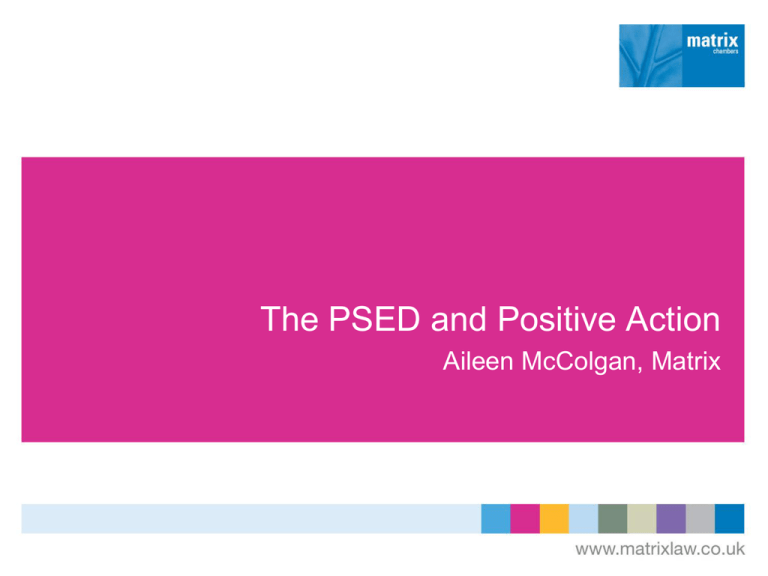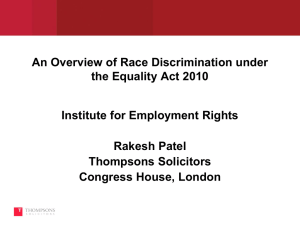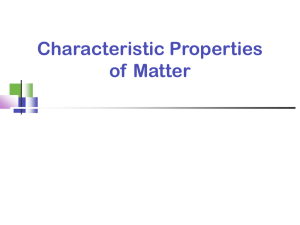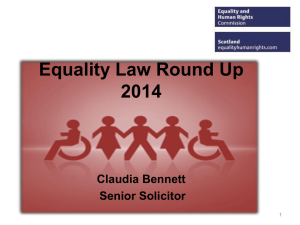
The PSED and Positive Action
Aileen McColgan, Matrix
The Statutory Equality Needs:
Giving Regard Where it is Due
Purpose and History
“it is incumbent upon every institution to
examine their policies and the outcome
of their policies and practices to guard
against disadvantaging any section of
our communities”
Sir William MacPherson
A new approach to equality
•
•
•
•
From restitution to mainstreaming
From tort model to public law duty
Pre-emptive duty of consideration
From avoiding to discrimination to
promoting equality
S149 Equality Act 2010
(1) A public authority must, in the exercise of its functions,
have due regard to the need to—
(a) eliminate discrimination, harassment, victimisation and
any other conduct that is prohibited by or under this Act;
(b) advance equality of opportunity between persons who
share a relevant protected characteristic and persons
who do not share it;
(c) foster good relations between persons who share a
relevant protected characteristic and persons who do not
share it.
Protected characteristics
•
•
•
•
•
•
•
•
Age
Disability
Gender reassignment
Pregnancy and maternity
Race
Religion or belief
Sex
Sexual orientation
(3) Having due regard to the need to advance equality of opportunity
between persons who share a relevant protected characteristic and
persons who do not share it involves having due regard, in particular, to the
need to—
(a) remove or minimise disadvantages suffered by persons who share a
relevant protected characteristic that are connected to that characteristic;
(b) take steps to meet the needs of persons who share a relevant protected
characteristic that are different from the needs of persons who do not share
it;
(c) encourage persons who share a relevant protected characteristic to
participate in public life or in any other activity in which participation by such
persons is disproportionately low.
(5) Having due regard to the need to foster good relations between persons
who share a relevant protected characteristic and persons who do not
share it involves having due regard, in particular, to the need to—
(a) tackle prejudice, and
(b) promote understanding.
General principles from the caselaw (1)
• Decision makers must be aware of their “due regard” duties:
– Kaur & Shah v Ealing LBC [2008] EWHC 2062 (Admin)
– Domb v Hammersmith and Fulham LBC [2009] EWCA 941
– Chavda v London Borough of Harrow [2007] EWHC 3064
(Admin)
– Baker v Secretary of State for Communities and Local
Government [2008] EWCA Civ 141;
– Brown v Secretary of State for Work and Pensions [2008]
EWHC 3158 (Admin);
– Brooke v Secretary of State for Justice [2009] EWHC 1396
(Admin)
Principles (2)
• “Due regard” is regard that is appropriate in
all the circumstances – proportionality is the
key
• The duty concerns the decision making
process – it does not dictate the outcome.
• The duty must be exercised with rigour and
with an open mind
Principles (3)
• Timing: must be fulfilled before and at the
time of the decision
• A continuing duty
• The need for an EIA?
When should an EIA be carried out?
• Not every policy needs one: screening
• Key concept is relevance
• Who is it likely to affect and in what way? Are
any of the equality strands likely to be
relevant?
Key steps in an EIA
•
•
•
•
Identify what equality strands the policy might affect
What evidence already exists about potential impact?
What further evidence is needed?
Consultation – Rahman v Birmingham City Council [2011] EWHC 944
(Admin):
1. Undertaken at a time when proposals are still at a formative stage;
2. Sufficient reasons must be provided to permit those intelligent
consideration and response;
3. Adequate time must be given;
4. Product of consultation must be conscientiously taken into account
when the ultimate decision is taken.
R v Brent London Borough Council ex p Gunning [1985] 84 LGR 168.
Assessing the impact – the hard part
•
•
•
•
•
•
•
•
•
What are the main findings – do they reveal any issues relevant to the equality
strands. For example...
Could outcome of policy differ according to people’s ethnic group, gender, disability,
sex etc
Is there evidence of higher/lower uptake of the service/benefit among different
groups?
If so, or if different impacts on different groups, is that consistent with policy
objective?
Could policy disadvantage people from one or more groups?
If there is differential impact that disadvantages one group, how can that impact be
minimised consistent with the need to take into account overall policy objectives,
which may include cost savings.
Do effects amount to unlawful discrimination?
Does policy promote equality of opportunity? If not, could it be changed to do so?
Does policy foster good relations between people of different groups? If not, could it
do so?
And finally: some basic truths
•
•
•
•
•
•
•
•
•
•
•
•
EIAs are not an end in themselves – they are a way of showing that due regard has been paid to the
general duties.
EIAs should be an integral part of policy development and review, not a one-off or separate exercise.
EIAs are not just about addressing discrimination or adverse impact; they should also positively promote equal
opportunities, improved access, participation in public life and good relations.
A policy should be impact-assessed if it is relevant to equality, with the most relevant policies assessed first
and most thoroughly.
The quality of an EIA is not measured by its page count but by the quality of the analysis, the action
taken as a result and the outcomes achieved through implementation.
The time and effort involved should be in proportion to the relevance of the policy.
Without good evidence, a good EIA will be difficult to achieve.
Lack of data is never an excuse for not assessing impact – some data will almost always be available and
where data isn’t available it must be actively gathered.
The information and insights that can be gained from involvement and consultation are essential, and
involvement and consultation should also usually be carried out as part of the main policy development
process.
EIAs should always include an action plan.
EIAs must always inform the final decision on a policy.
Unless your policy is already perfect for equality (which is highly unlikely), an EIA should lead to policy change.
Positive Action
Positive discrimination: the default position
It is unlawful to:
• treat someone less favourably because of a protected
characteristic
• treat someone more favourably because of a protected
characteristic
Exceptions:
• Disability
• Age
• Political parties
‘Positive action’: the general idea
‘the Act does not prohibit the use of positive action measures to
alleviate disadvantage experienced by people who share a
protected characteristic, reduce their under-representation in
relation to particular activities, and meet their particular needs. It
will, for example, allow measures to be targeted at particular
groups, including training to enable them to gain employment, or
health services to address their needs.’
Explanatory notes
Positive action is voluntary
S.158
Positive actions: general
S.159
Positive actions: recruitment and promotion
Positive actions: general
If P reasonably thinks people with a protected characteristic:
• suffer a disadvantage connected to a protected characteristic
• have needs which are different from others
• participate in disproportionately low numbers in an activity
‘some indication or evidence will be required to show that one of
these statutory conditions applies. It does not, however, need
to be sophisticated data or research.’
Employment Code of Practice
• Then P can take any action which is a proportionate means of
achieving the aim of addressing one or more of those issues
• Proportionality involves ‘the balancing of competing relevant
factors’
• Is the action an appropriate way to achieve the stated aim?
• Is the action reasonably necessary to achieve the aim – would it
be possible to achieve the aim as effectively by other actions
that are less likely to result in less favourable treatment of
others?
Examples
Police: under-reporting of anti-Semitic crime; evidence of lack of
trust within Jewish community
• Positive action: team dedicated to anti-Semitic crime
• Positive action: dedicated reporting points for anti-Semitic crime
British Judo Association: disproportionately low number of women
competitors
• Positive action: offer twice as much prize money to women
• Positive action: dedicated advertising campaign aimed at women
• Positive action: special offers on training courses for women
Positive action: recruitment/promotion
159 (1) This secton applies if a person (P) reasonably thinks that—
(a) persons who share a protected characteristic suffer a disadvantage connected to
the characteristic, or
(b) participation in an activity by persons who share a protected characteristic is
disproportionately low.
(2) Part 5 (work) does not prohibit P from taking action within subsection (3) with the
aim of enabling or encouraging persons who share the protected characteristic to—
(a) overcome or minimise that disadvantage, or
(b) participate in that activity.
(3) That action is treating a person (A) more favourably in connection with recruitment
or promotion than another person (B) because A has the protected characteristic but B
does not.
(4) But subsection (2) applies only if—
(a) A is as qualified as B to be recruited or promoted,
(b) P does not have a policy of treating persons who share the protected characteristic
more favourably in connection with recruitment or promotion than persons who do not
share it, and
(c) taking the action in question is a proportionate means of achieving the aim referred
to in subsection (2).
Positive action: recruitment/promotion
Differences:
• Does not include positive action to address ‘different needs’
• The person treated more favourably must be ‘as qualified’ as
the person treated less favourably’
‘a judgment based on the criteria the employer uses to
establish who is best for the job’ Explanatory Notes
• The employer may not have ‘a policy of treating persons who
share the protected characteristic more favourably’
‘each case must be considered on its merits’
Explanatory
Notes
EU law
• ‘as a derogation from an individual right laid down in
the Directive [these kinds of provisions] must be
interpreted strictly’ (Kalanke)
• ‘the Directive precludes national rules such as those in
the present case which, where candidates of different
sexes shortlisted for promotion are equally qualified,
automatically give priority to women in sectors where
they are underrepresented.’ (Kalanke)
‘A measure which is intended to give priority in promotion to
women in sectors of the public service where they are underrepresented must be regarded as compatible with Community
law if
• it does not automatically and unconditionally give priority to
women when men and women are equally qualified, and
• the candidatures are the subject of an objective assessment
which takes account of the specific personal situations of all
candidates.’ (Badeck)
Examples
A solicitor’s firm has disproportionately few women partners.
• it decides to interview all female applicants.
• having concluded that a female and male candidate were
both equally qualified for partnership, it decides to offer the
role to the female candidate
An employer has very few employees over the age of 50
• it has an open day specifically for older candidates
• it decides to restrict applications for a new vacancy to
candidates over 50
• it states on its advertising that it specifically encourages
applications from candidates over 50
Conclusion
A valuable opportunity to address disadvantages
But caution:
• Burden of proof?
• Objective assessment by court/tribunal
• If action does not meet the conditions, it will probably be
unlawful discrimination
=











